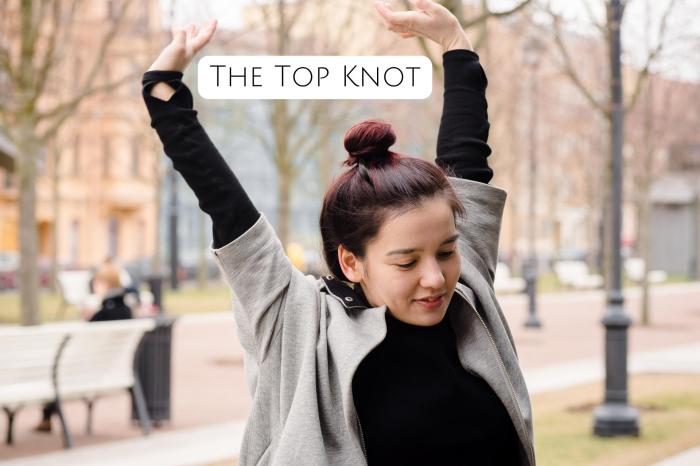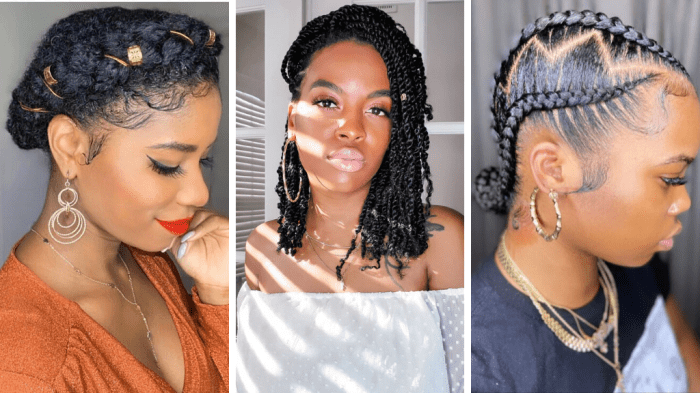Protective Hairstyles for Curly Hair
Understanding Curly Hair Types and Needs
Protective hairstyles for curly hair – Curly hair, encompassing a wide spectrum of textures and patterns, requires a specialized approach to care and styling. Understanding the unique needs of different curl types is crucial for maintaining healthy, vibrant hair and achieving successful protective styles.
Curly Hair Types and Their Protection Needs
Curly hair is categorized into types ranging from 2A (loose waves) to 4C (tight coils), each with distinct characteristics and protection requirements. Type 2 hair generally requires less intense protection than types 3 and 4, which are prone to dryness and breakage due to their tighter curl patterns and lower sebum distribution. Type 4 hair, in particular, needs extra care due to its delicate nature and tendency to become extremely dry.
Challenges Faced by Curly Hair and Protective Styling Solutions
Common challenges faced by curly hair include dryness, breakage, frizz, and shrinkage. Protective styles address these issues by minimizing manipulation, reducing exposure to environmental stressors, and promoting moisture retention. By keeping the ends tucked away and reducing friction, protective styles help prevent breakage and split ends, while also minimizing the need for daily styling, thus preserving moisture.
Curly Hair Texture and Protective Style Suitability
The suitability of a protective style depends heavily on the hair’s texture. For example, looser curls (2A-2C) might be suitable for styles like loose braids or twist-outs, while tighter curls (3C-4C) may benefit from styles that offer more structure and protection, such as cornrows or bantu knots. Heavier styles may weigh down finer hair, while smaller styles might be too time-consuming for very thick hair.
Careful consideration of hair texture is crucial for selecting an appropriate protective style.
Protecting curly hair involves minimizing manipulation and friction. Many protective styles focus on keeping ends tucked away, and a great way to achieve this is through various updos. For inspiration on stylish and protective options, explore the diverse range of natural hair updo hairstyles available. Ultimately, choosing a protective style for your curls boils down to finding a balance between style and safeguarding your hair’s health.
Popular Protective Hairstyles
Numerous protective hairstyles exist, each offering unique benefits and potential drawbacks. The choice depends on factors such as hair length, texture, time commitment, and personal preference.
| Hairstyle Name | Description | Benefits | Potential Drawbacks |
|---|---|---|---|
| Box Braids | Small, square-shaped braids that are usually close to the scalp. | Long-lasting, versatile, protective. | Can be time-consuming to install, potential for scalp irritation if too tight. |
| Cornrows | Braids that are closely interwoven and lie flat against the scalp. | Neat, stylish, protective. | Can be painful if braided too tightly, requires skill to install. |
| Twists | Two strands of hair are twisted together to create a rope-like effect. | Less tension than braids, easier to install than braids. | Can be prone to unraveling if not properly secured. |
| Bantu Knots | Sections of hair are twisted and wrapped around themselves to form knots. | Easy to install and maintain, great for stretching curls. | May not be suitable for all hair lengths. |
| Wigs | A covering for the head made of natural or synthetic hair. | Versatile, quick styling option, protects natural hair completely. | Can be expensive, requires proper care and maintenance. |
| Weaves | Hair extensions are sewn or glued onto cornrows or braids. | Adds length and volume, highly versatile. | Can damage natural hair if not properly installed and maintained. |
| Crochet Braids | Hair extensions are crocheted onto cornrows or braids. | Lightweight, quicker installation than traditional sew-ins. | Can be tricky to install properly, needs practice. |
| Flexi Rods | Flexible rods used to create soft curls or waves. | Low manipulation, gentle on hair. | Can be time-consuming, may not last as long as other styles. |
Materials such as braiding hair, hair extensions, and styling products play a significant role in the success and health impact of each protective style. Synthetic materials may offer a more budget-friendly option, but natural hair is generally gentler on the scalp and hair.
Maintaining Protective Styles
Proper maintenance is crucial to prevent issues like breakage, scalp irritation, and dryness. This involves regular cleansing, moisturizing, and attention to the scalp’s health.
Preventing Breakage and Scalp Irritation
Avoid overly tight styles, which can cause traction alopecia. Use gentle, moisturizing products to keep the scalp and hair hydrated. Regularly check for any signs of irritation or breakage.
Cleansing and Conditioning While Maintaining the Style
Use gentle, sulfate-free shampoos and conditioners to cleanse the scalp and hair without stripping away essential oils. Focus on the scalp when shampooing and use a leave-in conditioner to maintain moisture.
Regular Moisturizing and Deep Conditioning
Deep condition your hair at least once a week to replenish moisture and strength. Use a leave-in conditioner and hair oil daily to maintain moisture and prevent dryness.
Taking Down Protective Styles
Removing protective styles requires patience and care to minimize damage. The process varies depending on the style, but generally involves gentle detangling and careful removal of any attachments.
Safe Removal Methods for Each Hairstyle
Each hairstyle requires a specific removal technique. For example, braids should be carefully unraveled, while wigs and weaves should be professionally removed to prevent damage. Using a detangling spray or conditioner can help ease the process and reduce breakage.
Addressing Potential Problems During Removal
Common problems include tangles, breakage, and matting. Using a detangling spray and working slowly and gently can help prevent these issues. If encountering significant difficulty, seeking professional help is recommended.
Detangling and Nourishing After Removal

Source: kiwla.com
After removing a protective style, gently detangle the hair using a wide-tooth comb or your fingers, starting from the ends and working your way up. Follow with a deep conditioning treatment to replenish moisture and strength.
Choosing the Right Protective Style
The best protective style depends on various factors, including hair length, density, lifestyle, and personal preference.
Protective Style Selection Based on Hair Characteristics, Protective hairstyles for curly hair
Individuals with shorter hair may opt for styles like twist-outs or bantu knots, while those with longer hair may choose braids, weaves, or wigs. Hair density also influences style selection; thicker hair can support heavier styles, while finer hair might benefit from lighter options.
Determining Appropriate Style Duration

Source: curlygirlswag.com
The ideal duration of a protective style depends on individual hair health and the chosen style. Generally, styles should be worn for no more than 8-12 weeks to avoid excessive build-up and potential damage.
Consulting a Professional Hairstylist
Consulting a professional hairstylist experienced in curly hair is highly recommended, especially for complex styles or if you have concerns about your hair’s health.
Protective Styling and Hair Growth
Protective styling can significantly contribute to hair growth by minimizing breakage and manipulation. However, it’s important to note that protective styles alone don’t magically grow hair; proper hair care practices are essential.
Impact of Different Protective Styles on Hair Growth
Styles that minimize manipulation, such as braids and twists, generally promote better hair growth than styles that involve more tension or manipulation. Proper scalp care is also crucial for healthy hair growth.
Scalp Health and Hair Care Techniques for Optimal Growth
Maintaining a healthy scalp is key for hair growth. This includes regular cleansing, moisturizing, and avoiding overly tight styles. A balanced diet and proper hydration also play significant roles in hair health and growth.
Addressing Common Concerns
Despite the benefits, protective styling can lead to issues like scalp irritation, breakage, and even hair loss if not properly managed.
Scalp Health, Hair Breakage, and Hair Loss
Tight styles can cause traction alopecia, leading to hair loss. Dryness and improper maintenance can contribute to breakage. Regular scalp checks and proper maintenance are crucial for preventing these issues.
Preventative Measures and Solutions
Using gentle products, avoiding overly tight styles, and maintaining proper hygiene can help prevent these problems. Addressing any issues promptly can minimize damage.
Troubleshooting Common Problems
If experiencing scalp irritation, loosen the style or remove it. For breakage, address dryness and use gentle detangling techniques. Persistent issues should be addressed by a professional hairstylist.
FAQ Overview: Protective Hairstyles For Curly Hair
How often should I wash my hair while in a protective style?
This depends on the style and your scalp’s tendency towards oiliness. Generally, aim for washing every 1-2 weeks, using a sulfate-free cleanser. Focus on cleansing the scalp thoroughly.
Can I use heat styling tools on my protective style?
Heat styling is generally discouraged as it can damage both your hair and the style itself. Opt for heatless methods whenever possible.
How long should I keep a protective style in?
The optimal duration varies based on the style and your hair’s health. Generally, 6-8 weeks is a good guideline, but shorter periods might be necessary for styles that feel tight or cause scalp irritation.
What should I do if I experience scalp irritation?
If you notice any signs of irritation, such as itching or redness, remove the style immediately. Cleanse your scalp gently and consult a dermatologist or hairstylist if necessary.












